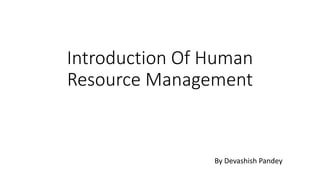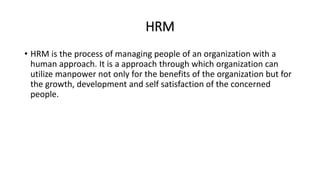Introduction Of Human Resource Management Unit -1.pptx
- 1. Introduction Of Human Resource Management By Devashish Pandey
- 2. Evolution Era • Industrial Era- 19th Century • Trade Union Movement Era – close to 19th Century • Social responsibility era- Beginning of 20th Century • Scientific Management era- 1900-20s • Human Relation era- 1930-50s • Behavioral Science era – 1950-60s • System and Contingency approach era – 1960 onwards • Human resource Management era -1980 onwards
- 3. HRM • HRM is the process of managing people of an organization with a human approach. It is a approach through which organization can utilize manpower not only for the benefits of the organization but for the growth, development and self satisfaction of the concerned people.
- 4. Nature of HRM • HRM is based on certain principles and policies which helps the organization to achieve its objectives. • HRM is a pervasive function – it suggest that hrm is not associated to a single department , instead it is a broader function and is spread through the organization ,which manages all type of employees from lower level to top level department of the organization . • HRM is People oriented • HRM is continuous activity • HRM is a part of management function • Main aim is optimum utilization of employees
- 5. Objectives of HRM • Human Capital • Developing organizational climate • Helping to maintain performance standards and increase productivity • Helping to establish and maintain a harmonious employee/employer relationship. • Helping to create and maintain a safe and healthy work environment • To increase the employee satisfaction and self actualization. • To communicate HR policies to all employees • To help maintain ethical policies and behavior
- 6. Objectives of HRM • Societal objectives • Organizational objectives • Functional objectives • Personnel objectives
- 7. Function of HRM • Strategic Management • Equal employment opportunity • Staffing • Talent Management • Total rewards • Risk Management and worker protection • Technological- Employee and Labor retention
- 8. Vital Qualities of HR Manager • Leadership skills • Communication skills • Self Discipline • Ethics and Integrity • Empathetic Attitude • Legally Sound
- 9. Role of the Manager • Personal role- Advising, Training and development, Manpower planning, selection and recruitment • Welfare and counselor role- research of personal and organizational problem, group behavior. • Administrative role- Salary and wage, Maintainace of records, Effective utilization of HR • Legal Role- Settlement of dispute, Grievance handling and handling discipline and legal matter
- 10. Emerging challenges of HRM • Work life Balance • Downsizing • Improvement of productivity • Creating of HRM function • Outsourcing of HRM function • Managing work force diversity • Empowerment of employees • Managing global workforce









